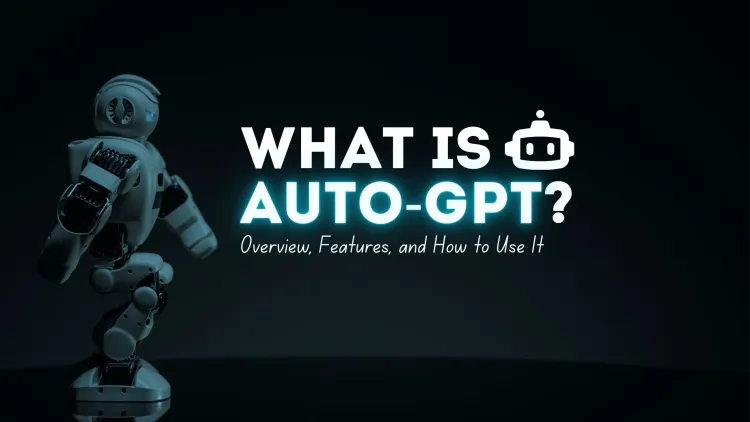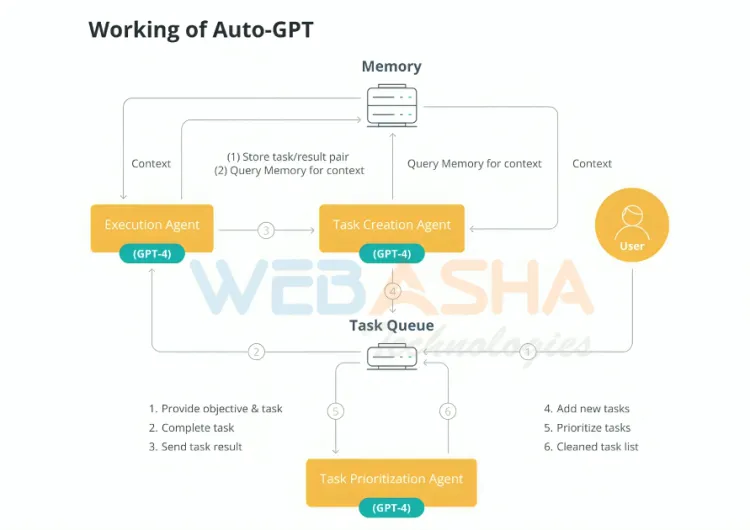What is AutoGPT: Overview, Features, and How to Use It
AutoGPT is an advanced AI framework that leverages GPT-4 for autonomous task execution. From content creation to e-commerce management, it offers a wide array of applications. Despite its limitations, its groundbreaking features mark a significant step toward the future of AI and AGI.

Artificial intelligence is revolutionizing the way we approach tasks, from automating repetitive processes to tackling complex problem-solving. Among these transformative tools is AutoGPT, a game-changing AI application that brings unparalleled autonomy and functionality to a variety of domains. This guide provides an in-depth look into AutoGPT, its framework, applications, and how you can get started.
Overview of AutoGPT
AutoGPT is an open-source Python-based AI application built on the robust capabilities of GPT-4, the latest model from OpenAI. Created by Toran Bruce Richards, this tool distinguishes itself by performing tasks independently based on a single prompt, removing the need for continuous human guidance. The backbone of AutoGPT is its use of AI agents, which autonomously gather data, analyze information, and execute tasks.

Key Features of AutoGPT
AutoGPT stands out due to its advanced features that enable seamless task automation:
-
Autonomous Task Execution: Unlike traditional AI tools that require step-by-step prompts, AutoGPT executes tasks independently by breaking them into logical steps.
-
Internet Access: AI agents within AutoGPT can browse the web, analyze data, and retrieve real-time information to fulfill objectives.
-
Versatile Applications: From content generation to business strategy development, AutoGPT caters to a wide range of use cases.
-
Integration Capabilities: It integrates easily with existing workflows, making it a valuable asset for developers and businesses alike.
Practical Applications of AutoGPT
AutoGPT’s flexibility has led to its adoption in diverse fields. Here are some of its notable applications:
-
Website Development: Build fully functional websites with minimal input.
-
Content Automation: Generate articles, blogs, and creative content with ease.
-
Marketing Strategies: Develop data-driven campaigns and analyze consumer behavior.
-
Product Reviews: Automate the creation of detailed and insightful reviews.
-
Graphic Design: Produce unique logos and branding materials.
-
Conversational AI: Build advanced chatbots for customer service or engagement.
Innovative users have also customized AutoGPT for specialized purposes:
-
Robo GPT: Streamlining software development tasks like debugging and code analysis.
-
E-Commerce GPT: Automating online business operations, from inventory management to customer interactions.
AutoGPT vs. AGI
Artificial General Intelligence (AGI) refers to AI systems that possess human-like cognitive abilities, enabling them to perform a wide array of tasks without specific programming. While AutoGPT isn’t fully AGI, its ability to autonomously perform tasks and adapt to new challenges hints at a future where AGI may become a reality. AutoGPT’s innovations bring us one step closer to achieving that milestone.
Comparing AutoGPT and ChatGPT
Although both AutoGPT and ChatGPT utilize GPT-4, they differ significantly in their functionalities:
| Feature | AutoGPT | ChatGPT |
|---|---|---|
| Task Management | Executes entire workflows autonomously | Provides responses to individual queries |
| Scope of Use | Handles complex projects and multi-step tasks | Suitable for straightforward Q&A |
| Autonomy | Highly autonomous | Relies on user prompts for each step |
| Real-Time Data | Accesses current data via the web | Limited to its training dataset |
How to Set Up and Use AutoGPT
Setting up AutoGPT may seem challenging for those without technical expertise, but following these steps can simplify the process:
-
Install Prerequisites:
-
Ensure you have Python 3.8 or later.
-
Obtain an OpenAI API key.
-
Download the necessary files from AutoGPT’s GitHub page.
-
-
Download AutoGPT:
-
Visit the GitHub repository and click on ‘Code’ to download the Zip file.
-
Choose the ‘Stable’ branch for a more reliable version.
-
-
Clone the Repository: Open your terminal and execute the following command:
git clone https://github.com/Torantulino/Auto-GPT.git -
Navigate to the Project Directory:
cd 'Auto-GPT' -
Install Required Libraries:
pip install -r requirements.txt -
Configure API Key:
-
Rename the
env.templatefile to.env. -
Enter your OPENAI_API_KEY in the designated field.
-
Once configured, you can name your bot and begin utilizing AutoGPT for various tasks.
Limitations of AutoGPT
While AutoGPT offers impressive capabilities, it’s not without drawbacks:
-
Resource Intensive: Running complex tasks can be costly and require significant computational power.
-
Limited Functionalities: Certain advanced tasks may still need human intervention.
-
Complex Setup: Non-technical users may find the initial configuration process challenging.
Conclusion
AutoGPT is a trailblazing AI tool that pushes the boundaries of task automation and intelligence. Its diverse applications, coupled with its ability to operate independently, make it a powerful asset in the AI ecosystem. However, users should be mindful of its limitations and deploy it strategically to harness its full potential.
FAQs
-
What is AutoGPT?
AutoGPT is an open-source AI tool designed to autonomously perform tasks based on user-defined objectives. -
Who developed AutoGPT?
AutoGPT was created by Toran Bruce Richards and is hosted on GitHub. -
What makes AutoGPT different from ChatGPT?
AutoGPT autonomously executes tasks, while ChatGPT relies on user input for each query. -
Can AutoGPT access real-time data?
Yes, it can browse the web to retrieve and analyze real-time information. -
What are the main applications of AutoGPT?
AutoGPT is used for web development, content creation, marketing strategies, and more. -
Is AutoGPT a form of AGI?
While not fully AGI, AutoGPT demonstrates characteristics that bring us closer to achieving AGI. -
What are the prerequisites for setting up AutoGPT?
You need Python 3.8 or later, an OpenAI API key, and the necessary files from GitHub. -
What are some specialized uses of AutoGPT?
Developers have customized AutoGPT for tasks like software debugging and e-commerce automation. -
Are there any limitations to AutoGPT?
Yes, it requires significant resources, has limited advanced functionalities, and involves a complex setup process. -
What is the future of AutoGPT?
As development continues, AutoGPT is expected to play a pivotal role in advancing AI and automation.











![Top 10 Ethical Hackers in the World [2025]](https://www.webasha.com/blog/uploads/images/202408/image_100x75_66c2f983c207b.webp)



![[2025] Top 100+ VAPT Interview Questions and Answers](https://www.webasha.com/blog/uploads/images/image_100x75_6512b1e4b64f7.jpg)







